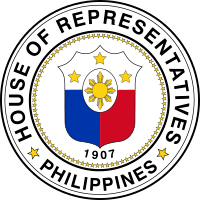Commission on Appointments
| Commission on Appointments Komisyon ng Paghirang | |
|---|---|
| 17th Congress of the Philippines | |
_%2C_Republic_of_the_Philippines.svg.png) | |
| Leadership | |
Chairperson | |
Vice chairperson | |
Majority floor leader |
Rodolfo Albano III, PDP-Laban |
Minority floor leader | |
| Structure | |
| Seats | 24, plus one ex officio member voting only to break ties |
| Committees | 23 standing committees |
Length of term | 3 years |
| Elections | |
| Election by majority and minority blocs in each chamber | |
| Meeting place | |
| GSIS Building, Pasay | |
| Website | |
| http://comappt.gov.ph/ | |
 |
|---|
| This article is part of a series on the politics and government of the Philippines |
|
Constitutional commissions |
The Commission on Appointments (Filipino: Komisyon sa Paghirang, abbreviated as CA) is a body of the Congress of the Philippines as provided by the Constitution. It confirms certain appointments made by the President of the Philippines. Article VII, Section 16 of the 1987 Constitution reads:
"The President shall nominate and, with the consent of the Commission on Appointments, appoint the heads of the executive departments, ambassadors, other public ministers and consuls, or officers of the armed forces from the rank of colonel or naval captain, and other officers whose appointments are vested in him in this Constitution. He shall also appoint all other officers of the Government whose appointments are not otherwise provided for by law, and those whom he may be authorized by law to appoint. The Congress may, by law, vest the appointment of other officers lower in rank in the President alone, in the courts, or in the heads of departments, agencies, commissions, or boards.[1]
The only government official that is exempted is the Vice-President's appointment to a cabinet post. The nomination of a person to the Vice Presidency due to vacancy is handled by both houses of Congress, voting separately.
During the operation of the 1935 constitution, replaced in 1971, the commission was composed of 12 senators and 12 representatives. During the operation of the 1973 constitution, the president appointed at will, without "checks and balances" from the then parliament. The current constitution, which was ratified in 1987, brought back the 25-member commission.
Officials confirmed
- Heads of Executive Departments
- Ambassadors, other Public Ministers and Consuls
- Officers of the Armed Forces from the rank of Colonel or Naval Captain
- Regular Members of the Judicial and Bar Council
- Chairman and Commissioners of the Civil Service Commission
- Chairman and Commissioners of the Commission on Elections
- Chairman and Commissioners of the Commission on Audit
- Members of the Regional and Consultative Commissions
- Chief of Philippine National Police
However, the appointments of all judges and the Ombudsman shall not be confirmed by the Commission on Appointments. Instead, they are recommended by the Judicial and Bar Council, and the President shall select from the recommendations.
Composition
The Commission is composed of the Senate President, the ex officio Chairman, twelve Senators and twelve members of the House of Representatives. Members from each House of Congress are elected based on proportional representation from the political parties and parties or organizations registered under the party-list system represented. The Chairman of the Commission shall vote only in case of a tie. It shall act on all appointments submitted within thirty session days of Congress. It shall be governed by a majority vote of all members.[2]
Procedure
A president can either make a nomination or an appointment. Either action involves the commission.
Most presidential actions are ad interim appointments, done when Congress is not in session. In these cases, the appointment allows the official to discharge the duties related to the office immediately. The ad interim appointment ceases to be valid if the commission explicitly rejects the appointment, or if the commission "bypasses" the appointment, or if the commission confirms the appointment. If the commission rejects the appointment, the official is no longer allowed to discharged the duties related to the office, and the president has to appoint someone else. If the commission bypasses the official, the president can re-appoint that person.
The president can also nominate an official if Congress is in session. In a "regular" nomination, the official can only discharge the duties once the commission consents with the appointment.
Just as other legislative bodies, the commission is divided into different committees. Each appointment is coursed through the committee concerned. After hearings are held, the committee decides to confirm or reject the appointment; the commission en banc then deliberates on whether to accept the committee's decision.
Meeting place
The commission meets at the GSIS Complex in Pasay, the seat of the Senate.
Current members
Members for the 17th Congress as of March 7, 2017:[3]
Party composition
|
Bloc composition
| ||||||||||||||||||||||||||||||||||||||||||||||||||||||||||||||||||||||||||||||||||||||||
Rejection of appointment
Rejection by the commission of the president's appointment is very rare. Usually, due to the padrino system of patronage politics, the president's party controls a supermajority of votes in the House of Representatives, thus mirroring its composition of the commission. This means appointments are almost always are approved, although some are not without difficulty.
During the ongoing presidency of Rodrigo Duterte, five of his appointments were rejected. These are:
- Perfecto Yasay, for Secretary of Foreign Affairs[5]
- Gina Lopez, for Secretary of Environment and Natural Resources[6]
- Judy Taguiwalo, for Secretary of Social Welfare and Development[7]
- Rafael V. Mariano, for Secretary of Agrarian Reform[8]
- Paulyn Ubial, for Secretary of Health[9]
Other administrations also had a few of its appointments rejected. These were:[10]
- Ricardo Saludo, for chairman of the Civil Service Commission in 2009 by Gloria Macapagal-Arroyo
- Ramon del Rosario, Jr, for Secretary of Finance in 1993 by Fidel V. Ramos
See also
- Appointments Clause, clause in the United States Constitution where the commission is based from.
References
- ↑ The 1987 Constitution of the Republic of the Philippines, Chan Robles law library.
- ↑ Commission on Appointments Official Website
- ↑ "17th Congress Officers and Members". Commission on Appointments. Retrieved August 17, 2017.
- ↑ Elemia, Camille (21 May 2018). "Tito Sotto elected as Senate president". Rappler. Retrieved 21 May 2018.
- ↑ "Commission on Appointments rejects Yasay". ABS-CBN News. 2017-03-08. Retrieved 11 June 2017.
- ↑ Santos, Elmor P. (2017-05-04). "CA rejects Gina Lopez appointment as DENR chief". CNN Philippines. Retrieved 11 June 2017.
- ↑ Alvarez, Kathrina Charmaine (16 August 2017). "CA rejects Taguiwalo as DSWD secretary". GMA News Online. Retrieved 16 August 2017.
- ↑ Geronimo, Jee Y. (September 6, 2017). "CA rejects Rafael Mariano as agrarian reform secretary". Rappler. Retrieved September 6, 2017.
- ↑ Placido, Dharel (10 October 2017). "Ubial rejected as health secretary". ABS-CBN News. Retrieved 10 October 2017.
- ↑ "Is Yasay the first appointee to be rejected by the CA?". Rappler. 2017-03-08. Retrieved 11 June 2017.

